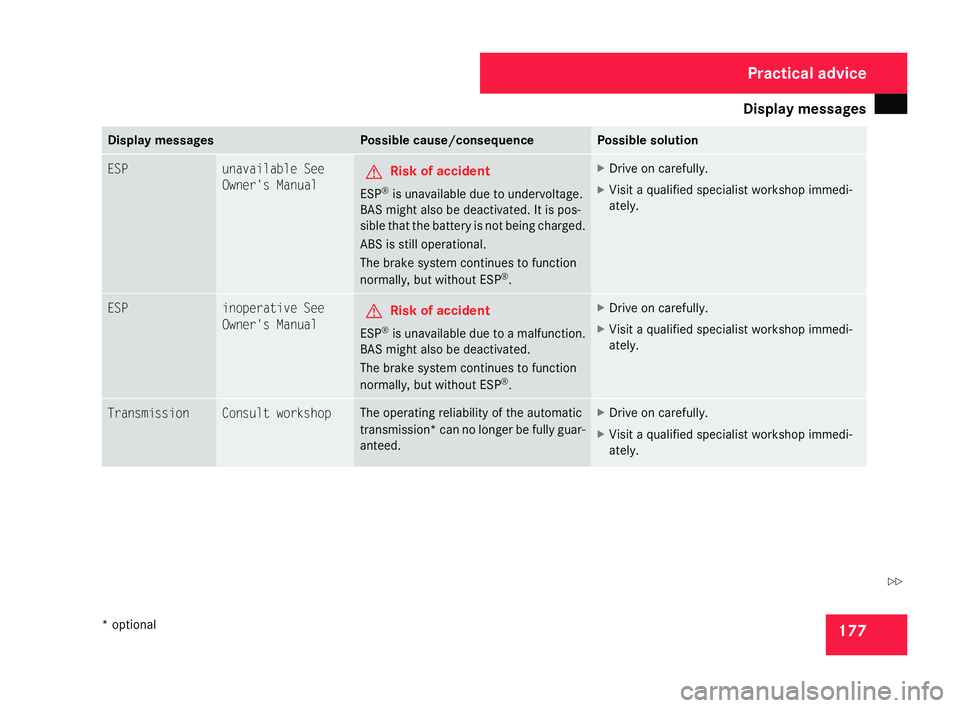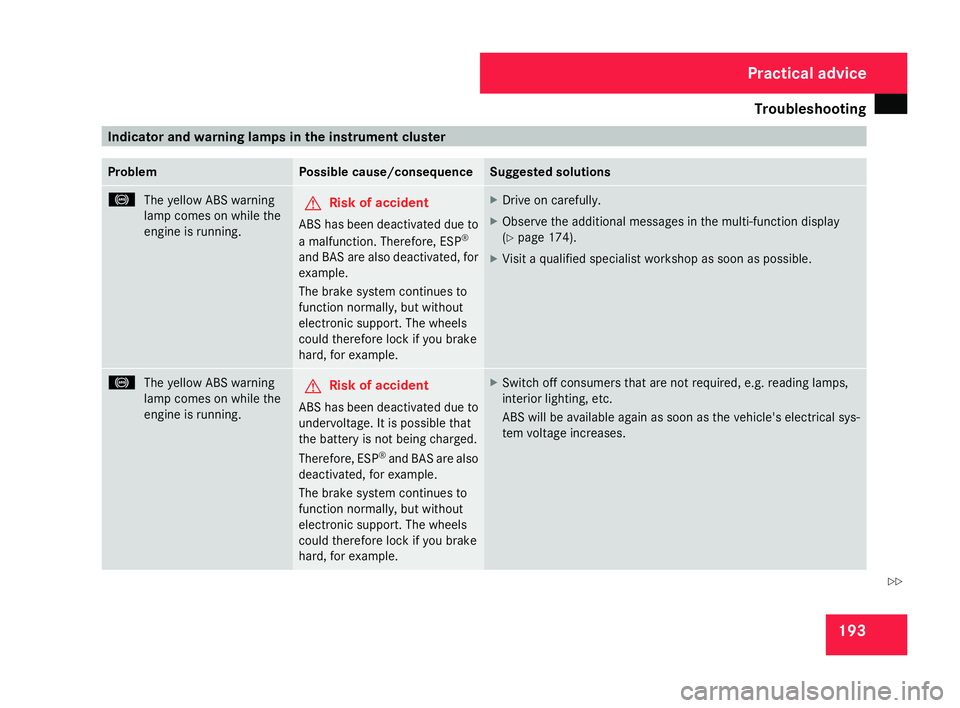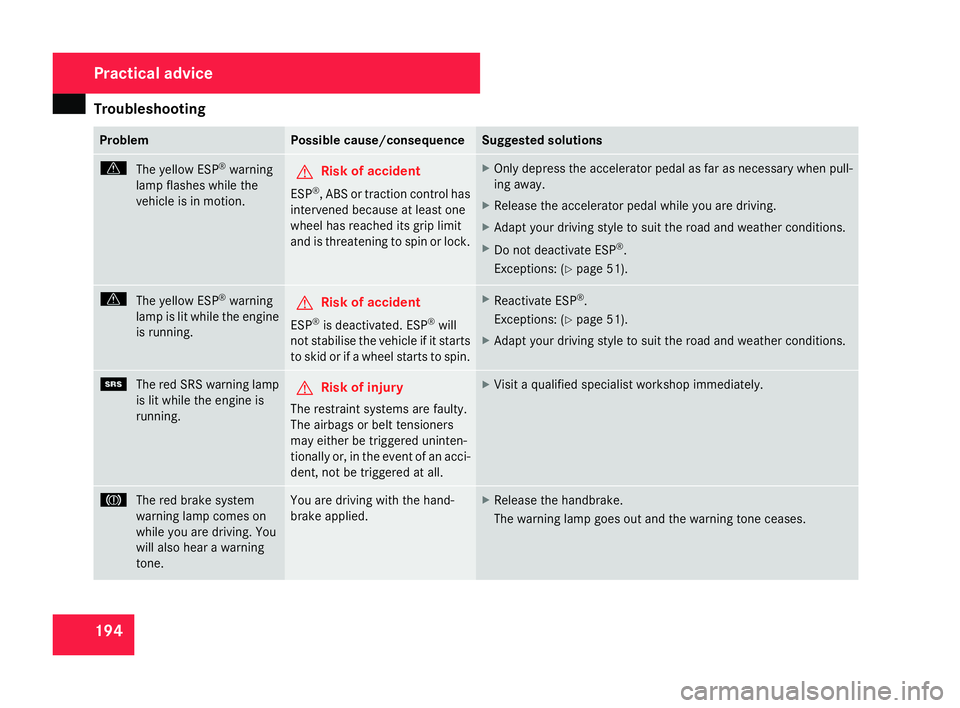2008 MERCEDES-BENZ SLK ROADSTER ABS
[x] Cancel search: ABSPage 163 of 273

Winter driving
160 Interchanging the wheels
G
Risk of accident
Interchange the front and rear wheels only
if they have the same dimensions: for exam-
ple size, offset, etc.
After every wheel interchange/change,
have the tightening torque checked at a
qualified specialist workshop that has the
necessary specialist knowledge and tools
to carry out the work required. Mercedes-
Benz recommends that you use a
Mercedes-Benz Service Centre for this pur-
pose. In particular, work relevant to safety
or on safety-related systems must be car-
ried out at a qualified specialist workshop.
The wheels could work loose if they are not
tightened to a torque of 110 Nm.
For safety reasons, Mercedes-Benz recom -
mends that you only use wheel bolts of the
correct size which have been approved for
Mercedes-Benz vehicles.
The wheels may be interchanged every 5,000
km to 10,000 km depending on the degree of
tyre wear, provided that the vehicle has the
same size front and rear tyres. Do not reverse
the direction of tyre rotation.
The wear patterns on the front and rear tyres
differ depending on the operating conditions. Interchange the wheels before a clear wear
pattern has formed on the tyres. The fron
t
tyres typically wear more on the shoulders
and the rear tyres in the centre.
Clean the contact surfaces of the wheel and
the brake disc thoroughly every time a whee l
is changed. Check the tyre pressure and, if
necessary, restart the tyre pressure loss
warning system*. Winter driving
Introduction to winter operation
Have your vehicle winterproofed at a qualified
specialist workshop, e.g. at a Mercedes-Ben z
Service Centre, at the onset of winter. Winter tyres
Use winter tyres at temperatures below +7 °
C and on snow or ice-covered roads. Only
then can the effect of the ABS and ES P®
driv-
ing systems be ensured in winter too.
Use winter tyres of the same make and tread
on all wheels to maintain safe handling char-
acteristics. G
Risk of accident
You must replace winter tyres with a trea d
depth of less than 4 mm immediately. They
are no longer suitable for winter use, in par-
ticular because they do not provide suffi-
cient grip. This could cause you to lose
control of your vehicle and cause an acci-
dent .
Always observe the maximum permitted
speed specified for the winter tyres you have
fitted. If you fit winter tyres which have a
lower maximum permitted speed than that of Operation
* optional
171_AKB; 3; 4, en-GB
vpfaff7,
2007-11-13T10:50:25+01:00 - Seite 160
Page 179 of 273

Display
messages 17
6 Display messages Possible cause/consequence Possible solution
120 km/
h Maximum speed
exceeded The maximum speed has been excee-
ded
26
. X
Drive more slowly . ABS ABS, ESP inopera-
tive See Owner's
Manual
G
Risk of accident
ABS and ESP ®
are unavailable due to a
fault. BAS has also been deactivated .
The brake system continues to function
normally, but without the functions listed
above. X
Drive on carefully.
X Visit a qualified specialist workshop immedi-
ately. ESP unavailable See
Owner's Manual
G
Risk of accident
ESP ®
is temporarily unavailable. It is pos-
sible that the self diagnosis is not yet
complete .
ABS is still operational .
The brake system continues to function
normally, but without ESP ®
. X
Drive a short distance at a speed above 20 km/
h.
If the display message disappears, ESP ®
is
available again. 26
Only for certain countries. Practical advice
171_AKB; 3; 4, en-GB
vpfaff7,
2007-11-13T10:50:25+01:00 - Seite 176
Page 180 of 273

Display
messages 17
7 Display messages Possible cause/consequence Possible solution
ESP unavailable See
Owner's Manual
G
Risk of accident
ESP ®
is unavailable due to undervoltage.
BAS might also be deactivated. It is pos-
sible that the battery is not being charged.
ABS is still operational.
The brake system continues to function
normally, but without ES P®
. X
Drive on carefully.
X Visit a qualified specialist workshop immedi-
ately. ESP inoperative See
Owner's Manual
G
Risk of accident
ESP ®
is unavailable due to a malfunction.
BAS might also be deactivated.
The brake system continues to function
normally, but without ES P®
. X
Drive on carefully.
X Visit a qualified specialist workshop immedi-
ately. Transmission Consult workshop The operating reliability of the automatic
transmission* can no longer be fully guar-
anteed. X
Drive on carefully.
X Visit a qualified specialist workshop immedi-
ately. Practical advice
* optional
171_AKB; 3; 4, en-GB
vpfaff7,
2007-11-13T10:50:25+01:00 - Seite 177 Z
Page 196 of 273

Troubleshooting
19
3 Indicator and warning lamps in the instrument cluster
Problem Possible cause/consequence Suggested solutions
-
The yellow ABS warning
lamp comes on while the
engine is running. G
Risk of accident
ABS has been deactivated due to
a malfunction. Therefore, ESP ®
and BAS are also deactivated, for
example .
The brake system continues to
function normally, but without
electronic support. The wheels
could therefore lock if you brake
hard, for example. X
Drive on carefully.
X Observe the additional messages in the multi-function display
(Y page 174).
X Visit a qualified specialist workshop as soon as possible. -
The yellow ABS warning
lamp comes on while the
engine is running. G
Risk of accident
ABS has been deactivated due to
undervoltage. It is possible that
the battery is not being charged.
Therefore, ESP ®
and BAS are also
deactivated, for example .
The brake system continues to
function normally, but without
electronic support. The wheels
could therefore lock if you brake
hard, for example. X
Switch off consumers that are not required, e.g. reading lamps ,
interior lighting, etc .
ABS will be available again as soon as the vehicle's electrical sys-
tem voltage increases . Practical advice
171_AKB; 3; 4, en-GB
vpfaff7,
2007-11-13T10:50:25+01:00 - Seite 193 Z
Page 197 of 273

Troubleshooting
19
4 Problem Possible cause/consequence Suggested solutions
v
The yellow ESP ®
warning
lamp flashes while th e
vehicle is in motion. G
Risk of accident
ESP ®
, ABS or traction control has
intervened because at least one
wheel has reached its grip limit
and is threatening to spin or lock . X
Only depress the accelerator pedal as far as necessary when pull-
ing away.
X Release the accelerator pedal while you are driving.
X Adapt your driving style to suit the road and weather conditions.
X Do not deactivate ESP ®
.
Exceptions: (Y page 51). v
The yellow ESP ®
warning
lamp is lit while the engine
is running. G
Risk of accident
ESP ®
is deactivated. ES P®
will
not stabilise the vehicle if it start s
to skid or if a wheel starts to spin. X
Reactivate ES P®
.
Exceptions: (Y page 51).
X Adapt your driving style to suit the road and weather conditions. 1
The red SRS warning lamp
is lit while the engine is
running. G
Risk of injury
The restraint systems are faulty .
The airbags or belt tensioners
may either be triggered uninten-
tionally or, in the event of an acci-
dent, not be triggered at all. X
Visit a qualified specialist workshop immediately. 3
The red brake system
warning lamp comes on
while you are driving. You
will also hear a warning
tone. You are driving with the hand-
brake applied. X
Release the handbrake .
The warning lamp goes out and the warning tone ceases. Practical advice
171_AKB; 3; 4, en-GB
vpfaff7,
2007-11-13T10:50:25+01:00 - Seite 194
Page 249 of 273

Tyres and wheels
24
6 Tyres and wheels
! For safety reasons, Mercedes-Benz rec-
ommends that you only use tyres which
have been approved by Mercedes-Benz
specifically for your vehicle. These tyres ar e
specially adapted for use with the control
systems, such as ABS or ESP ®
, and are
marked as follows:
R MO = Mercedes-Benz Original
R MOE = Mercedes-Benz Original Exten-
ded* (with run-flat characteristics)
If you use other tyres, Mercedes-Benz can-
not accept any responsibility for damage
which may occur. Information about tyres
can be obtained from any Mercedes-Ben z
Service Centre.
! If you fit tyres other than those tested and
recommended by Mercedes-Benz, charac-
teristics such as handling, noise levels and
fuel consumption, etc. may be adversel y
affected. In addition, when driving with a
load, dimensional variations and differen t
tyre deformation characteristics could
cause the tyres to make contact with the
bodywork and axle components. This could
result in damage to the tyres or the vehicle. i
Further information about tyres and
wheels can be obtained from any
Mercedes-Benz Service Centre.
You will find a table of tyre pressures on the
inside of your vehicle's fuel filler flap . You
will find further information about tyre pres-
sures in the "Operation" section
( Y page 157). Technical data
* optional
171_AKB; 3; 4, en-GB
vpfaff7,
2007-11-13T10:50:25+01:00 - Seite 246
Page 263 of 273

Service products and capacities
260
Capacities The following values indicate the total cooling system capacities.
SLK 200 KOMPRESSOR SLK 280 SLK 350 SLK 55 AMG
Coolant 8.2
l 9.8
l 9.8
l 11.1
l Amount of antifreeze/corrosion inhibitor required for antifreeze protection
Down to –37 °C
(approximately 50%) 4.1
l 4.9
l 4.9
l 5.55
l Down to –45 °C
(approximately 55%) 4.5
l 5.4
l 5.4
l 6.1
l Brake fluid
Over a period of time, the brake fluid absorbs
moisture from the air; this lowers its boiling
point. G
Risk of accident
If the boiling point of the brake fluid is too
low, vapour pockets may form in the brake
system when the brakes are applied hard
(e.g. when driving downhill). This woul d
impair braking efficiency.
Have the brake fluid renewed every two
years with a brake fluid that has been approved by Mercedes-Benz and have this
confirmed in the Service Booklet.
i There is usually a notice in the engine
compartment to remind you when the next
brake fluid change is due. Windscreen washer system
The washer fluid reservoir holds approxi-
mately 7 litres.
The headlamp cleaning system* and the
windscreen washer system are both supplied
from the washer fluid reservoir.
X At temperatures above freezing point:
Top up the washer fluid reservoir with a
mixture of water and windscreen washer
concentrate (Y page 154).
X At temperatures below freezing point:
Top up the washer fluid reservoir with a
mixture of water, antifreeze and wind-
screen washer concentrate (Y page 154). Technical data
* optional
171_AKB; 3; 4, en-GB
vpfaff7,
2007-11-13T10:50:25+01:00 - Seite 260